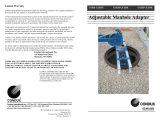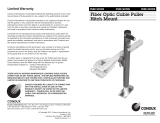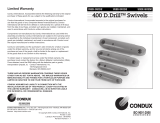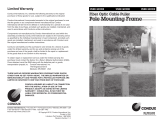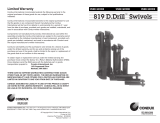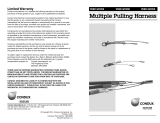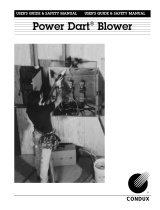Page is loading ...

WDR505 Underground Pulling Trailer
USER'S GUIDE & SAFETY MANUAL USER'S GUIDE & SAFETY MANUAL

2
Read and understand all procedures and safety instructions before using a Condux Underground Pulling
Trailers. Observe all safety information on this page and note specific safety requirements as explained
by procedures in this manual. Failure to follow these instructions could result in serious personal injury or
death.
Important Safety Notice
ADVERTENCIA:
Favor de leer y comprender todas las instucciones de operación y seguridad antes de usar la máquina. Si
Ud. no comprende las instrucciones favor de consultarle a su jefe.
If you have questions on:
SAFETY - OPERATIONS - APPLICATIONS
CALL 1-800-533-2077
Save this user’s guide for future reference.
COMMUNICATIONS WITH THE MANUFACTURER:
For information related to the machine (use, maintenance, spare parts) always-state model number,
manufacturing Year and Order. This date can be found on the parts identification label.
Manufacturer:
Condux International, Inc.
145 Kingswood Drive
Mankato, MN 56002-0247
1-507-387-6576
Fax 1-507-387-1442
E-mail: [email protected]om

3
Table of Contents
General Information ................................................................................4
Technical Specifications .............................................................................6
A. Operational Conditions ....................................................................6
B. Hydraulic Oil ...............................................................................6
C. Noise Emissions ...........................................................................6
Safety Information ..................................................................................7
A. Safety Devices .............................................................................7
B. Emergency Stop Devices ...................................................................7
C. Periodic Operations ........................................................................7
D. Cautions & Warnings .......................................................................7
E. Pulling Rope Failure ........................................................................7
F. Rotating Component Pinch-Point Hazards ..................................................8
G. Crushing Injury when Loading or Unloading Rope or Conductor Reels ......................8
H. Electrostatic Discharges. . . . . . . . . . . . . . . . . . . . . . . . . . . . . . . . . . . . . . . . . . . . . . . . . . . . . . . . . . . . . . . . . . . .8
I. Inhalation Engine Exhausting Gas ...........................................................8
Transporting ........................................................................................9
A. Machine Lifting ............................................................................9
B. Packing for Shipment ......................................................................9
C. Unpacking ................................................................................9
D. Towing ....................................................................................9
Operating Procedures ............................................................................. 10
A. Positioning the Trailer & Lower Boom ....................................................10
B. Stabilize Trailer. . . . . . . . . . . . . . . . . . . . . . . . . . . . . . . . . . . . . . . . . . . . . . . . . . . . . . . . . . . . . . . . . . . . . . . . . . . 10
C. Start Puller ..............................................................................11
D. Payout Winch Line ....................................................................... 11
E. Prepare for Pullback ...................................................................... 12
F. Electronic Control Box (ECB) Set-up (Optional) ............................................ 12
G. Pullback ................................................................................. 13
H. Shut down .............................................................................. 13
Maintenance ......................................................................................13
A. General Procedures ...................................................................... 13
B. Fluid Levels .............................................................................. 13
C. Suggested Lubricants .................................................................... 13
D. Hydraulic Circuit Maintenance ........................................................... 14
E. Reduction Unit and Reel Winder Negative Brake Maintenance .............................14
F. Oil Maintenance ......................................................................... 15
G. Greasing ................................................................................ 15
H. Electronics Note ......................................................................... 15
I. Summary Table for Ordinary Maintenance ................................................. 16
J. Extended Storage ........................................................................ 16
Troubleshooting Guide ............................................................................17
Appendices .......................................................................................22
A. Hydraulic Oil Filters ...................................................................... 22
B. Engine Air Filter .......................................................................... 22
C. Engine ..................................................................................22
D. Suggested Lubricants ....................................................................23
E. Parts Breakdown ......................................................................... 24
Notes ............................................................................................ 25
Warranty Information ............................................................................. 27
1
2
3
4
5
6
7
8
9
10

4
General Information
PRODUCT DESCRIPTION
The WDR505 pulling trailer provides up to 11,240 lbs. of pulling force and a max
speed of 219 ft/min. It comes equipped with a digital meter counter, hydraulic
dynamometer with set point and automatic control of the maximum pull, a noise
reduction kit, as well as 1,640 feet of anti-twist rope a key feature. Anti-twist rope
offers high flexibility, complete stability to rotation and increased efficiency during
pulling operation.
An optional Electronic Control Box to monitor pulling speeds and tension is available,
as well as an extension arm with multiple pulling positions to accommodate most
applications. Condux International manufactures a complete line of cable installation
tools and equipment.
SAFETY INFORMATION
• Only trained and qualified operators should use this machine.
• Qualified operators are those persons who have received training from the
machine owner’s company or, alternatively, from the manufacturer.
• This machine must be used only for the work it was designed for.
• This machine should not be used with unauthorized personnel on the work site.
• For any questions regarding operation, function, maintenance, etc., contact the
After-sales Service of the manufacturer.
OPERATOR INFORMATION
• Operators must be aware of all local, state and federal safety regulations
governing the use of this equipment.
• Operators must wear suitable clothing to reduce the possibility of entanglement
in the machine’s moving parts. They should avoid the wearing of chains, and
other jewelry for the same reason.
• Operators must use personal protective gear (i.e. gloves, boots, helmet, etc.).
• Operators must carefully follow hazard related instructions contained in this
instruction manual or indicated on the machine.
• This machine’s work area should be free as possible of oil or other liquid spills
as well as materials or equipment that may be considered as an obstacle to
proper operation.
• The operator must absolutely avoid the direct inhalation of the system’s engine
exhaust gas.
GENERAL MAINTENANCE INFORMATION
• It is absolutely forbidden to carry out any maintenance, or adjust any settings
on this machine while pulling (except for those indicated in this manual).
• Before carrying out any maintenance stop the engine (except for those
instances indicated otherwise in this manual) and wait till the system
components subject to heating have cooled sufficiently
• All the maintenance performed on this machine must be carried out on a level
surface and while the system is not under load.
• Authorized and trained personnel must perform all of the maintenance, both
scheduled maintenance and repair. Authorized and trained personnel are those
persons who have received training on the maintenance of this equipment from
the machine owner’s company or, as alternative, from the manufacturer.
• Maintenance personnel must wear suitable clothes to reduce the possibility of
entanglement in the machine’s moving parts. They should avoid the wearing of
chains, and other jewelry for the same reason.
1.

5
• Operators must use personal protective gear (i.e. gloves, boots, helmet, etc.).
• All maintenance operations, both scheduled and repair, must be carried out
per the instructions included in this manual or following technical instructions
provided by the manufacturer. Failure to follow these instructions relieves the
manufacturer from any responsibility and voids their warranty.
MACHINE USAGE
The machine must not be used:
• For lifting persons and/or goods
• In a location where the machine can not be positioned and anchored in a
proper way
• In areas with brush or other materials that can be easily set on fire
• In closed/unventilated sites or those poorly ventilated (tunnel or similar)
• At sites where fuels or explosives are present
• For structure demolition
• For the pulling of elastic elements
• With ropes or joints having a bigger diameter than that specified in this manual
• With over-ridden or broken safety system devices
• For handling trucks or other movable equipment
RESPONSIBILITY
Use of the machine in situations different from those indicated in paragraph 2.3
(Typology and using field), or those not described in this manual, is to be considered
extremely dangerous and/or forbidden.
Persons not using recommended restraints cause a situation of improper use, and
relieve the manufacturer from any responsibility for accidents, injuries to persons or
damage to property. The manufacturer’s warranty is also voided.
Similarly the manufacturer’s responsibility ends when the following situations occur:
• Tampering and/or modifying of the system without the manufacturer’s written
acceptance (in this case the operator becomes the manufacturer assuming all
obligations and responsibilities, both civil and penal).
• The use of non-original spare parts.
• Poor maintenance.
• Use with disconnected or over-ridden safety devices.
• For the connection to machine and/or plans not produced and not directly
authorized by the manufacturer in a written acceptance.
OPERATORS MANUAL
• Information contained in this manual applies to all the operators charged with
the use and/or the maintenance of the machine.
• This instruction manual is not a training manual.
• Before using the machine the job site supervisor and the operators must read
this instruction manual.
• The supervisor is obliged to inform all operators about the instructions
contained in this manual.
• All operators user must carefully follow the instructions contained in this manual.
• Before using the machine the operator must know the positions and the
operation of all the controls.
• The job site supervisor must verify that the instructions contained in this manual
are applied.
• This instruction manual must be kept with the machine, for the entire life of the
machine, so it is available to all potential users and operators.
• The instruction manual must be kept in a sheltered and dry place.

6
Technical Specifications
The Condux WDR505 Hydraulic Underground Pulling Trailer provides up to 9,000 lbs
of continuous pulling force. Designed for installing underground cable, the WDR-505
is completely self-contained and transports easily from jobsite to jobsite. Industry
leading features like antiwist rope and modular extension arms make the WDR-505
the most advanced puller in the market today. An advanced electronic information
system is also available for monitoring and documenting vital pulling functions.
A. OPERATIONAL CONDITIONS
Temperature: from -10°C to +40°C.
Relevant moisture: from 30% to 90% ± 5%.
Weather conditions: any (in line with working conditions).
Natural and/or artificial lighting of the working site.
B. HYDRAULIC OIL
When using the machine always keep in mind operating conditions and their
effect on the possibility of your exceeding the following temperature limits for the
system’s hydraulic oil.
TEMPERATURE LIMITS FOR HYDRAULIC OIL (°C)
Working condition ATF
oil
Hydraulic oil viscosity
VG 22 VG 32 VG 46 VG 68
Minimum temperature running in neutral position -15 -21 -14 -7 -1
Minimum temperature running in full load 19 8 16 24 32
Maximum temperature running in full load 66 48 57 67 76
Maximum temperature running in neutral position 84 63 73 83 93
For additional information concerning the hydraulic oil, see chapter “Maintenance”
and the attached comparative table of the oils used on the machine.
C. NOISE EMISSION
Level of acoustic power (2000/14/CE) LwA = 102 dB(A)
Maximim sound pressure level to the operator seat (ISO 11202 – December
1995) Lep = 83 dB(A)
4.2.
GENERAL SPECIFICATIONS PULLER
MAX LINE PULL, POUNDS 11,250
SPEED AT CONTINUOUS PULL, POUNDS 9,000
HIGH SPEED CONTINUOUS PULL, POUNDS 2,250
PULLING SPEED FEET PER MINUTE 0–219
BULL WHEEL DIA., INCHES 13
MAX ROPE DIA., INCHES 9/16
FEET OF ROPE 2,300
ENGINE TYPE DIESEL
HORSEPOWER 46
ELECTRICAL SYSTEM 12 Volt

7
3.3.
Safety Information
A. SAFETY DEVICES
Machine has been equipped with the following safety devices:
• A load-limiting device that automatically stops the engine once the max.
pre-set load value has been exceeded
• A mechanical negative safety brake that stops all movement if hydraulic
pressure is lost
• Where possible, guards and covers are provided to protect personnel from
moving parts
!DANGER: it is absolutely forbidden to use this machine with
protective guards removed or with damaged or disconnected
safety devices.
B. EMERGENCY STOP DEVICE
An emergency stop button is provided (Figure 1) on the control panel. Pushing it
immediately stops the engine.
!CAUTION: Use of the emergency stop
is ONLY recommended in emergency
situations. It is NOT recommended to
use the emergency stop system for
normal shut down of the system.
C. PERIODIC OPERATIONS
Proper functioning of safety systems should be
verified daily.
!CAUTION: Any customer alterations
to the provided safely devices relieves
the manufacturer of any responsibility
for any resulting damage of property or
injury to personnel.
D. CAUTIONS & WARNINGS
When operating this machine users must be aware of other risks associated with
the work for which the machine is intended.
E. PULLING ROPE FAILURE
Obviously this will cause uncontrolled movement of the entire machine. Both this
and the danger then presented by the pulling rope and/or conductor can cause
serious injury or death.
To reduce operator exposure to these dangers owners must:
• Regularly check the rope and replace it as soon as defects or signs of wear
are detected
• Assume only the recommended operation positions indicated in this manual
Figure 1. Emergency Stop Button

8
F. ROTATING COMPONENT PINCHPOINT HAZARDS
Due to the nature of the work being performed and important system
functionality, it is not possible to fully guard all rotating components.
To minimize risks operators must:
• Avoid any contact with the machine’s rotating components
• Follow the anchoring instructions described in this manual
• Follow all recommendations in this manual regarding the use of personal
safety equipment
G. CRUSHING INJURY WHEN LOADING OR UNLOADING ROPE OR
CONDUCTOR REELS
Operators must know the proper methods for executing these tasks and should
be trained to do them properly.
H. ELECTROSTATIC DISCHARGES
To reduce the risk presented by static electric charge build up in the ropes and
conductors during pulling operations, the machine must be properly grounded.
To minimize these risks operators must:
• Be trained in, and apply, the proper methods used to ground the machine
during before using the machine.
I. INHALATION ENGINE EXHAUSTING GAS
To minimize these risks operators must:
• Assume the proper operating position during operation and use appropriate
safety equipment as needed

9
Transporting
A. MACHINE LIFTING
For machine lifting use only devices (overhead traveling cranes, lift trucks, ropes,
cables, hooks, etc.) with a capacity equal to the weight to be lifted.
Personel should not be on the machine when it is lifted.
!DANGER: Failure to follow the recommendations in this section
may create a dangerous situation and/or damage to the machine.
The manufacturer’s warranty may also become void as a result.
B. PACKAGING FOR SHIPMENT
Transport by land by truck
Certain surfaces may be protected by cardboard and/or plywood and/or
polyethylene film.
To prevent movement, use nailed wheel chocks. Attach the machine to the floor
of a truck box or trailer using chains and hooks at the attachment points provided.
C. UNPACKING
When receiving the machine verify the condition of the package; immediately
notify the transportation company and the manufacturer (use photos whenever
possible) of any damage that may have occurred during shipment.
Verify that the supplied product matches that which was ordered; immediately
advise the manufacturer if there is a discrepancy.
Use caution when unpacking to avoid damaging the product.
!CAUTION: Disposal of all packaging materials must be in
accordance with local regulations.
D. TOWING
This machine is designed for towing at highway speeds. No personnel may ride
on the machine at any time while towing the machine at ANY speed.
3.4.

Operating Procedures
It is essential that the Underground Pulling Trailer be properly set up before operation.
Using the following procedure will allow the unit to be set up in a short period of time
and yield optimum performance.
A. POSITIONING THE TRAILER & LOWER BOOM
Position the WDR 505 Puller within an approximate boom arm reach of the
manhole or duct bank. After trailer is positioned, lower boom arm.
NOTE: It may be necessary to payout a small amount of winch line (releasing it
from the boom) first to allow the boom to be lowered. If so please refer to Steps
C and D before proceeding.
Remove the traveling pin and carefully lower the boom to the position desired for
pulling operations (Figure 2). Once in position lock the boom in place with the pin
(Figure 3).
Now that the boom is in place, minor adjustments in the puller’s position can be
made if necessary for optimum working alignment.
B. STABILIZE TRAILER
After the WDR 505 is properly positioned, place wheel chocks to prevent trailer
movement.
NOTE: The trailer may be disconnected
from the tow vehicle or left connected
depending on specific site conditions.
After placing wheel chocks, stabilize the
trailer using three of the five supplied
adjustable leveling jacks. Place three
jacks in the jack mount locations on the
trailer. Raise and lower jacks by
rotating crank handle (Figure 4). Place
two jacks on the boom arm and adjust
jacks until the boom arm is level to the
ground (Figure 5).
10
Figure 2. Remove Traveling Pin Figure 3. Lock Boom in Place
5.5.
Figure 4. Rotating Crank Handle

11
C. START PULLER
Open control panel on side of WDR 505 and secure. Start the engine by holding
the glow plug rocker switch unit the glow plug indicator light goes out (Figure 6).
Turn the ignition key while holding the glow plug rocker switch until the OK light
comes on (Figure 7). Adjust the throttle so the engine runs at a medium RPM.
D. PAYOUT WINCH LINE
Payout the winch line by pushing the winch line joystick up. The joystick is
infinitely variable so payout speed can be varied by the degree to which the
joystick is moved.
IMPORTANT: Always keep tension on the winch line when paying it out to
prevent slack from developing in bull wheel.
In typical applications, the winch line will need to be paid out to reach the work
area first, i.e. manhole, duct bank, etc. Then prepped for pullback, ie, pulled
through duct bank with a pulling rope or tape or installed with a Condux Winch
Line Blower.
Figure 5. Boom Arm Level to
the Ground
Figure 6. Hold Glow Plug
Rocker Switch
Figure 7. Turn Ingition Key while
Holding Rocker Switch

E. PREPARE FOR PULLBACK
Verify that reel winder pressure gauge is reading between 580 and 870 PSI. If
the gauge is reading higher or lower adjust by turning the pressure adjust knob
until pressure reads between 580 and 870 (Figure 8).
Adjust Maximum Tension Limiter to desired maximum pulling tension value
(measured in tons) by inserting the black removable knob into the center of the
large dial. Press down on the block knob and rotate until the large red needed is
adjusted to the desire value. This will be the maximum pulling force the machine
will exert. Once the limit is reached the entire system will shut down and a
warning sound will be activated. (Figure 9).
F. ELECTRONIC CONTROL BOX ECB SETUP OPTIONAL
If the WDR 505 is equipped with an ECB, set ECB parameters at this time. Refer to WDR
505 Quick Reference Guide Section - DLR100 Programming and Set Up for ECB set up
instructions.
G. PULLBACK
To start pullback, pull winch line joystick down. The speed of the pullback can be
increased by increasing the throttle. During pullback make sure to monitor pull force
and speed.
H. SHUT DOWN
At the end of the pull, relieve pulling rope tension using the control lever. Turn off igni-
tion key.
12
Figure 8. Verify Reel Winder
Pressure Gauge
Figure 9. Adjust Maximum
Tension Limiter

13
Maintenance
A. GENERAL PROCEDURES
!CAUTION: Any customer repairs not authorized by the
manufacturer relieves the manufacturer of any responsibility for any result-
ing damage of property or injury to personnel.
B. FLUID LEVELS
Due to safety and/or regulatory reasons, this machine may arrive without
hydraulic oil and fuel.
Fill the levels as per the following table:
Fluids Quantity
Hydraulic oil level (table 1, pos. 1) 100 l – 26.4 gal
Engine oil level (see enclosed engine booklet)
Fuel level (table 1, pos. 4) 28 l – 8 gal
Negative brake for bull-wheel oil level (table 1, pos. 8) 0.3 l – 0.08 gal
Negative brake for reel winder oil level (table 2, pos. 3) 0.4 l – 0.1 gal
!CAUTION: Not filling fluids to those levels specified above will
cause serious damage to system components and voids all
product warranties.
!DANGER: Purposely ingesting hydraulic liquids, fuels and cooling
liquids is potentially lethal.
C. SUGGESTED LUBRICANTS
The manufacturer tests the machine with the following oils and lubricants:
hydraulic circuit and negative brake: IP HYDRUS OIL 46 (ISO VG 46).
Alternates must be chosen from the enclosed table “SUGGESTED
LUBRICANTS”. It is possible to use different products, but they must have the
same characteristics and ISO specifications.
!CAUTION: The use of lubricants not in conformity with the
technical specifications indicated in the referenced table can
seriously damage the machine, its components and voids all
product warranties.
!DANGER: Let the engine cool prior to performing any
maintenance, or before refueling.
D. HYDRAULIC CIRCUIT MAINTENANCE
Change the hydraulic oil after 500 working hours, then every 1500 hours (or at
least annually).
To drain the hydraulic oil remove the hydraulic tank’s drain plug (table 2, pos. 6).
!DANGER: Allow the hydraulic oil to completely cool before
removing it. Always use suitable safety gear (gloves, etc.).
3.6.

14
!CAUTION: Disposal of all drained system oils and fluids must be in accor-
dance with local regulations.
Fill the hydraulic oil using the filler spout designated on table 1, pos. 2.
!CAUTION: insure that no foreign matter enters the system along
with the oil; if possible filter the oil with a 10 µm filter.
Replace the filter cartridge after 500 working hours and then, every 1500 hours
(or at least annually).
Check that the hydraulic oil filter lamp lights only during start-up. If lit ant any
other time it indicates that the hydraulic oil filter needs replacing.
For further maintenance instructions on the hydraulic components (pumps and
motors) refer to the enclosed documentation.
E. REDUCTION UNIT AND REEL WINDER NEGATIVE BRAKE
MAINTENANCE
Change the oil of the bull-wheel reduction unit and negative brake (table 1, pos.
8) and of the reel winder brake after 50 working hours and, thereafter, every 500
hours (or at least annually).
To drain the reduction unit and negative brake’s oil use the plugs on the lower
part of their housings.
!DANGER: Allow the oil to completely cool before removing it.
Always use suitable safety gear (gloves, etc.).
!CAUTION: Disposal of all drained system oils and fluids must be
in accordance with local regulations.
Fill the oil into the reduction unit and in the negative brakes using the proper fill
spout
!CAUTION: insure that no foreign matter enters the system along with the
oil.
For further maintenance instructions on these subsystems (reduction gear,
negative brakes) refer to the enclosed documentation.

15
F. OIL MAINTENANCE
At least once a year, or as frequently as required, using compressed air, blow all debris
from the fins of the oil coolers.
!CAUTION: Personnel cleaning the oil coolers as per above should wear all
required personal protective gear, including a
respirator.
G. GREASING
There are 5 key points of contact on your WDR505 that requires greasing after every
day or sooner if they appear to be drying up. They include:
A) Take-up reel bearings (Both Side) B) Level wind shaft C) Guide shaft
D) Gearing (Zerk located under control panel)
*Use IP ATHESIA GR2 (ISO XBCEA 2) grease or equivalent from the enclosed
“SUGGESTED LUBRICANTS” table.
SUMMARY TABLE FOR ORDINARY MAINTENANCE
This table Located on Page 16 will lists the recommended service intervals for the
WDR505 including all required grease points needed for daily maintenance and beyond.
H. ELECTRONICS NOTE
When cleaning the machine, avoid direct spraying of water or steam on electronic
components or the control panel.
For the other periodic operations refer to the summary table for the ordinary
maintenance (see next page).
Level wind shaft Guide shaft
Figure 10. Critical Grease Points
Take-up real Gearing

16
SUMMARY OF ORDINARY MAINTENANCE
Part Object Interval
Daily 50 h 250 h 500 h 1500 h
Diesel engine Engine oil CL ST
Oil filter ST
Cooling liquid CL ST
Air filter VF ST
Fuel CL
Hydraulic circuit Fuel filter ST
Hydraulic oil CL ST1 ST(*)
Filter VF ST1 ST(*)
Bull-wheel gear box Oil CL ST1 ST(*)
Bull-wheel negative
brake Oil CL ST1 ST(*)
Reel winder negative
brake Oil CL ST1 ST(*)
Bull-wheels greasing
circuit
Reel winder
Gears GR
Chain transmission GR
Level wind shaft GR
Guide shaft GR
Pawl VF
Legend:
CL Check the level (and possible filling up)
GR Grease
ST Replace
ST1 Replace (only for the first time)
VF Check
(*) Or in any case every year
J. EXTENDED STORAGE
When an extended storage period is anticipated (two months or more) coat
external parts with waterproof protectant.
During the storage period, start the machine at least once every two months and
let the engine idle for approx. one hour. Do this so that oil enters the hydraulic
system and coats all gaskets, o-rings, etc.
The machine should be stored under a roof. Do not tarp the machine as excess
moisture may collect under it and cause damage to the system.
If the machine is stored for a year or more, replace the hydraulic circuit’s oil and
filters prior to startup.

17
Troubleshooting Guide
3.7.
PROBLEM: CAUSE: SOLUTION:
The diesel engine starter
doesn’t work.
Burned fuse Replace
Ran down battery Recharge or replace
Disconnected contacts of the
ignition system / starter Reconnect
Oxidised contacts of the
ignition system / starter
Clean or spray with a
suitable vaporiser
Starter out of order Replace / Technical
assistance
Diesel engine doesn’t
work.
The emergency push-
button is pushed in locked
position
Release
The ignition push-button is
not pushed
Push the ignition push-
button and keep it
pushed till the engine
starts
The pre-heating glow plugs
warning light isn’t turned off
Wait for the turning off
of the pre-heating glow
plugs warning light
Fuel problem
Check the fuel level in
the tank
Check the fuel filter
Diesel engine turns
off when releasing the
ignition push-button.
Check of the engine oil
pressure
Add engine oil
Defective sensor–
check contacts /
replace
Engine anomaly –
technical assistance
Check of the engine cooling
liquid temperature
Add cooling liquid
Defective sensor–
check contacts /
replace
Engine anomaly –
technical assistance
The feeding pressure
is lower than 24 bar
– 340psi
Clogged hydraulic oil filter Replace
Defective pump Technical assistance
Diesel engine doesn’t
increase rpm
Disconnected accelerator
cable
Verify and if necessary
replace

18
PROBLEM: CAUSE: SOLUTION:
The clogged filter
warning light turns on.
Hydraulic oil temperature
too low
Wait for a few minutes
for heating the oil
without speed up the
diesel engine. It is
possible to reduce
the oil heating time
by turning off the fan
of the hydraulic oil
radiator (if turned on)
and by closing the reel
winder valve at 50 bar
– 725 psi
The oil is too thick
as regards as the
environmental conditions
Use oil with lower
viscosity as per the
indications in the
instruction manual
Clogged hydraulic oil filter Replace
When starting the
control lever the bull-
wheels don’t work.
Disconnect joy-stick
contacts Reconnect
Oxidised joy-stick contacts Clean or spray with a
suitable vaporiser
The negative brake on the
reduction unit doesn’t open
Verify the intervention
and the electric
contacts of the
negative brake opening
solenoid valve
Disassemble the brake
and verify if the brake
discs are in locking
position – technical
assistance
The electronic card for
pump control doesn’t work
Verify the ignition of
the green and red
LEDS on the card by
moving the joy-stick –
if the LEDS don’t turn
on, replace the fuse on
the card or verify the
joy-stick potentiometer
– technical assistance
Defective pump servo
control
Verify the electric
contacts – technical
assistance

19
PROBLEM: CAUSE: SOLUTION:
When moving the
control lever, the bull-
wheels rotate but the
rope doesn’t move
– slips on the bull-
wheels.
Reel winder pressure not
sufficient
Increase the reel
winder pressure
Replace the adjusting
valve for the reel
winder pressure
Reel winder pump
problem – technical
assistance
The negative brake on the
reel winder doesn’t open
Verify the intervention
and the electric
contacts of the
negative brake opening
solenoid valve
Disassemble the brake
and verify if the brake
discs are in locking
position – technical
assistance
Diesel engine turns off
during operations.
Check of the engine oil
pressure
Add engine oil
Defective sensor
– check contacts /
replace
Engine anomaly –
technical assistance
Check of the engine cooling
liquid temperature
Add cooling liquid
Defective sensor
– check contacts /
replace
Engine overheating
– technical assistance
Intervene of the pull limiting
device on the dynamometer
The max. pre-set pull
has been reached
Increase the intervene
threshold of the pull
limiting device
Operation of the emergency
push-button Release

20
PROBLEM: CAUSE: SOLUTION:
The machine doesn’t
reach the max. pull
performances.
Diesel engine rpm not
sufficient Speed up the engine
Diesel engine decreases
rpm and turns off
Decrease the control
lever capacity
Excessive hydraulic oil
temperature
Wait for a few minutes
for cooling the oil. It
is possible to reduce
the oil cooling time
by turning on the
fan of the hydraulic
oil radiator and by
completely opening
the reel winder valve
with diesel engine at
medium-high rpm
Insufficient fuel feeding at
diesel engine
Check the fuel filter
Fuel feeding system
to be adjusted –
Technical service
The machine doesn’t
increase speed.
Diesel engine rpm not
sufficient Speed up the engine
Diesel engine decreases
rpm and turns off
Decrease the control
lever capacity – the
applied pull doesn’t
allow to reach higher
speed
Excessive hydraulic oil
temperature
Wait for a few minutes
for cooling the oil. It
is possible to reduce
the oil cooling time
by turning on the
fan of the hydraulic
oil radiator and by
completely opening
the reel winder valve
with diesel engine at
medium-high rpm
Insufficient fuel feeding at
diesel engine
Check the fuel filter
Fuel feeding system
to be adjusted –
Technical service
/
